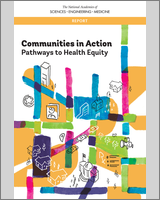NCBI Bookshelf. A service of the National Library of Medicine, National Institutes of Health.
In the United States, some populations suffer from far greater disparities in health than others. Those disparities are caused not only by fundamental differences in health status across segments of the population, but also because of inequities in factors that impact health status, so-called determinants of health.
Only part of an individual's health status depends on his or her behavior and choice; community-wide problems like poverty, unemployment, poor education, inadequate housing, poor public transportation, interpersonal violence, and decaying neighborhoods also contribute to health inequities, as well as the historic and ongoing interplay of structures, policies, and norms that shape lives. When these factors are not optimal in a community, it does not mean they are intractable: such inequities can be mitigated by social policies that can shape health in powerful ways.
Communities in Action: Pathways to Health Equity seeks to delineate the causes of and the solutions to health inequities in the United States. This report focuses on what communities can do to promote health equity, what actions are needed by the many and varied stakeholders that are part of communities or support them, as well as the root causes and structural barriers that need to be overcome.
Contents
- The National Academies of SCIENCES • ENGINEERING • MEDICINE
- COMMITTEE ON COMMUNITY-BASED SOLUTIONS TO PROMOTE HEALTH EQUITY IN THE UNITED STATES
- Reviewers
- Preface
- Acknowledgments
- Acronyms and Abbreviations
- Key Terms
- Summary
- 1. The Need to Promote Health Equity
- 2. The State of Health Disparities in the United States
- 3. The Root Causes of Health Inequity
- 4. The Role of Communities in Promoting Health Equity
- 5. Examples of Communities Tackling Health Inequity
- 6. Policies to Support Community Solutions
- 7. Partners in Promoting Health Equity in Communities
- 8. Community Tools to Promote Health Equity
- 9. Conclusion
- APPENDIXES
Suggested citation:
National Academies of Sciences, Engineering, and Medicine. 2017. Communities in action: Pathways to health equity. Washington, DC: The National Academies Press. doi: 10.17226/24624.
- NLM CatalogRelated NLM Catalog Entries
- Progress In Achieving Health Equity Requires Attention To Root Causes.[Health Aff (Millwood). 2017]Progress In Achieving Health Equity Requires Attention To Root Causes.Woolf SH. Health Aff (Millwood). 2017 Jun 1; 36(6):984-991.
- [Inequalities in health in Italy].[Epidemiol Prev. 2004][Inequalities in health in Italy].Caiazzo A, Cardano M, Cois E, Costa G, Marinacci C, Spadea T, Vannoni F, Venturini L. Epidemiol Prev. 2004 May-Jun; 28(3 Suppl):i-ix, 1-161.
- Surveillance for equity in maternal care in Zimbabwe.[World Health Stat Q. 1993]Surveillance for equity in maternal care in Zimbabwe.Taylor C, Sanders D, Bassett M, Goings S. World Health Stat Q. 1993; 46(4):242-7.
- Review Addressing social determinants of health inequities through settings: a rapid review.[Health Promot Int. 2015]Review Addressing social determinants of health inequities through settings: a rapid review.Newman L, Baum F, Javanparast S, O'Rourke K, Carlon L. Health Promot Int. 2015 Sep; 30 Suppl 2:ii126-43.
- Review Housing and Neighborhoods as Root Causes of Child Poverty.[Acad Pediatr. 2021]Review Housing and Neighborhoods as Root Causes of Child Poverty.Green KA, Bovell-Ammon A, Sandel M. Acad Pediatr. 2021 Nov-Dec; 21(8S):S194-S199.
- Communities in ActionCommunities in Action
- Clic2 chloride intracellular channel 2 [Rattus norvegicus]Clic2 chloride intracellular channel 2 [Rattus norvegicus]Gene ID:294141Gene
Your browsing activity is empty.
Activity recording is turned off.
See more...
